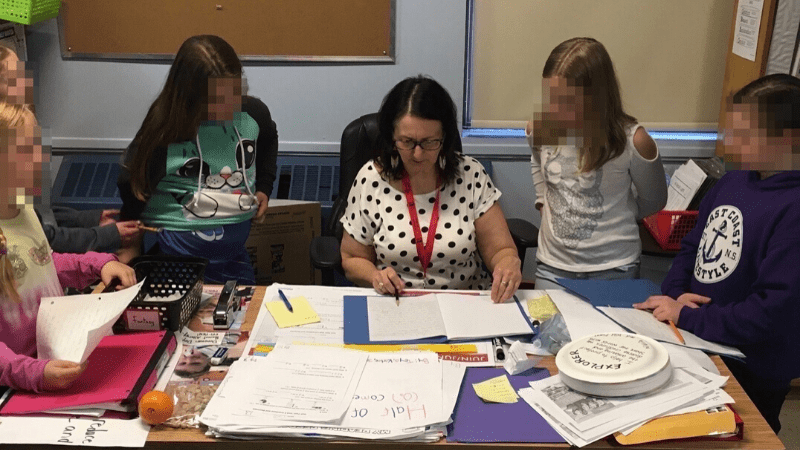When Juanita Romard first heard about the National Geographic Explorer Challenge, she thought it would be a great way to energize her language arts curriculum. It turns out that it would also empower her students to solve an environmental challenge in their school. Plus, it would help Juanita build her own skills and become a National Geographic Certified Educator. And the coolest part? Juanita and her students got to collaborate with a National Geographic Explorer—a professional marine ecologist—who worked with them along the way.
Featured Image Credit: National Geographic
The Importance of a Growth Mindset

Image Credit: Juanita Romard
To start, Juanita’s students identified ways they possess an “explorer’s mindset.” One student wrote that she is responsible. Another said he is willing to try new things. After some reflection, students realized they already had many of the skills it takes to make a difference.
Juanita then asked her students to set goals for becoming even more like a National Geographic Explorer, such as gaining observation skills, becoming better communicators, and learning how to collaborate.
Collaborating With a National Geographic Explorer
With the right mindset in place, it was time to team up with a National Geographic Explorer.
“They were pretty excited because National Geographic is such a well-known and respected organization,” said Juanita. “They felt honored because of that.”
Soon they learned they’d work with marine ecologist Carolina Chong-Montenegro, who studies small-scale fisheries off the coast of Colombia. With a specific focus on the Pacific goliath grouper, Chong-Montenegro’s research explores the effects of commercially exploitative fishing practices. Her research advocates for sustainable fishing that preserves marine-life populations.
The students’ first task was to email letters they’d written to Chong-Montenegro. They asked her their most thoughtful questions, such as “How has the population of the Pacific goliath grouper changed over time?” and “How would a fishing ban impact the livelihood of fishers?” The students also came up with interesting parallels between their local fisheries and those in Colombia.
A Memorable Classroom Experience
Chong-Montenegro responded to students’ questions in a video.
“I am sure that day will be the day from fourth grade they’ll remember for the rest of their lives,” said Juanita. “They were over the moon.”
Each time Chong-Montenegro addressed one of the students’ questions, they exclaimed things like, “That was me who said that!”
Working so closely with a real-life scientist made students feel like productive global citizens.
Integrated Studies and Differentiated Learning
Students integrated science and language arts to come up with hypotheses and solutions to the problem of overfishing.
“Kids think better out of the box when you model thinking outside of the box,” said Juanita.
Juanita also believes that integrated studies are more appropriate for differentiated learning environments and provide a more realistic view of the world.
“The systems of the world are all interconnected. Nothing is separate, and that is why I like to teach cross-curricular studies.”
Juanita also gave students the opportunity for individualized learning. Though they all kept a journal to record their process, they had the choice to present their theories in a variety of ways—through illustrations, models, graphs, charts, and more. One student even wrote a rap song!
Think Globally, Act Locally
Eventually, students arrived at a conclusion: One way to preserve marine life ecology is to reduce plastic waste.
So what came next? A school-wide campaign to reduce plastic use in the lunchroom. They collected data via a Google Form, counting how much plastic was being used at school. Then they went on a mission to reduce it.
“The kids compiled all that data, tallied it, and posted graphs so all the classes could see,” said Juanita. “They made different comparisons about what kinds of plastic products were being thrown into ocean waters—[storage bags], yogurt containers, etc.”
Then they made a poster campaign for Wrapperless Wednesdays and turned it into a school-wide competition. They even encouraged their fellow students to make a donation to a marine-related cause instead of buying balloons for birthday celebrations.
Support From National Geographic Educator Certification

Image Credit: Juanita Romard
While Juanita’s students were busy making waves in their school community, she was learning right alongside them. In the process of completing the National Geographic Explorer Challenge, Juanita decided to complete the National Geographic Educator Certification to strengthen her teaching.
This free three-month professional development program helps educators build their teaching and leadership skills so they can empower students to solve problems in their communities and beyond.
“It takes about 25 to 30 hours of your time,” said Juanita.
Juanita had an opportunity to hone her own “explorer’s mindset” through the certification program. Her capstone project was a video that incorporated the National Geographic Learning Framework while highlighting the experience her students had with Chong-Montenegro.
“I had never in my life made a video,” said Juanita. But if she expected a growth mindset from her students, she had to expect the same of herself.
Quality Resources for Long-Lasting Environmental Education
Juanita now finds herself using National Geographic’s library of free resources regularly in the classroom, which she says are invaluable for educators who want to respond to students’ growing interest in environmental topics.
Students are becoming more eco-conscious than ever “now that Greta Thunberg is making a buzz with her travels around the world,” says Juanita. “Recycling in schools began as a student movement, and now everybody is pretty conscious of it.”
And that makes sense. As Juanita’s students learned, when you change one element in a system, the whole world changes.
Want to Inspire the Next Generation of Changemakers?
National Geographic Educator Certification is a free professional development program for educators who are committed to empowering students to solve problems in their communities and beyond. Click the orange button below to learn more.

